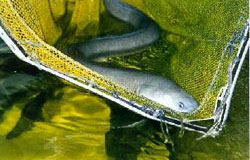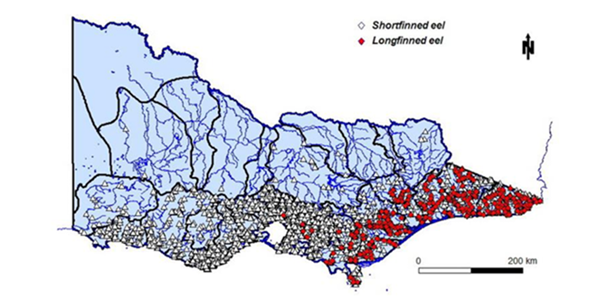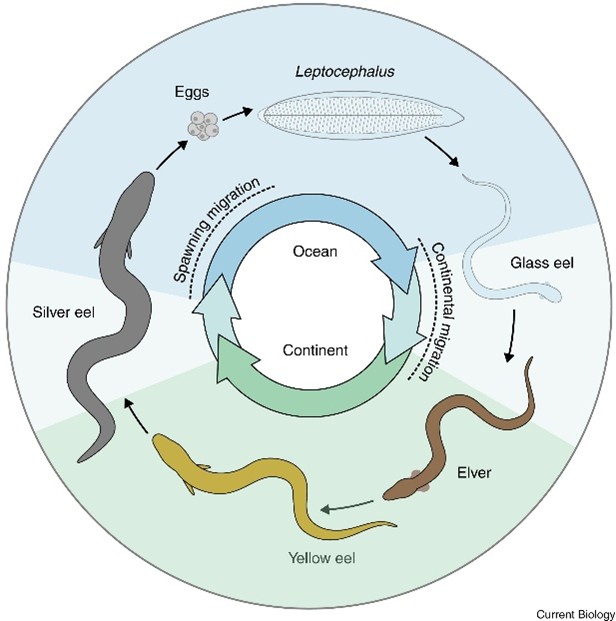Eel Fishery

The first commercial catches of eel were recorded in 1914 and until the 1950s the commercial Eel Fishery was based on supplying bait to the rock lobster and long-line shark fisheries. Export of frozen short-finned eels to Europe commenced in the early-mid 1960s. Most product is now sold (fresh, live or smoked) to Sydney and Melbourne fish markets.
Production in the Eel Fishery is strongly affected by seasonal factors and drought conditions have resulted in relatively low production for more than a decade. Some eel production continues to be through stock enhancement (open aquaculture), whereby small eels (elvers/snigs) are stocked into selected crown lakes for extensive on-growing under natural conditions. The commercial catch from stock enhanced waters is influenced by water levels and/or the availability of elvers/snigs.
The Eel Fishery is managed under the Victorian Eel Fishery Management Plan, which was most recently updated in August 2017. The Management Plan sets the objectives, strategies and actions for the fishery.
Key elements of the Eel Fishery
| Eel Fishery |
Species | Short-finned eel, Anguilla australis Long-finned eel, Anguilla reinhardtii |
Fishery boundary | Eel are harvested in Victorian coastal river basins south of the Great Dividing Range. Short-finned eels are found across the State, while long-finned eels are only found in eastern Victoria |
Fishing method | Fyke net |
Management method | The number, dimensions and mesh sizes of fyke nets are prescribed in regulation. Waterways closed to eel fishing which allows levels of adults escapement for spawning purposes. |
Maximum number of licences | 18 |
The species
The target species in Victoria's Eel Fishery are the short-finned eel (Anguilla australis) and long-finned eel (A. reinhardtii). The respective distributions of short-finned and long-finned eel are extensive and there is considerable overlap between the two. Short-finned eels are found from subtropical Queensland to western Victoria, Tasmania and New Zealand. Long-finned eels are distributed from far north Queensland to eastern Victoria and Tasmania. Specimens of the Australian long-finned eel have also been recorded in New Zealand.

Figure 1. Commercially targeted eel (short-finned and long-finned) capture locations (Source: Victorian Fisheries Authority)
Both species are classed as catadromous, and spend the majority of their life cycle in fresh water or estuaries but travel to the ocean to spawn - once before dying (Figure 2). Spawning is thought to occur in the vicinity of the Coral Sea, although no precise spawning location for either species has been identified. Eggs are thought to be pelagic and hatch after about two days. Larvae are transported southwards along the east coast of Australia where they metamorphose into glass eels and swim into coastal bays and estuaries. Most short-finned glass eels migrate in the winter and spring, while long-finned glass eels migrate during summer and autumn.

Figure 2. Eel (Anguillid sp.) catadromous lifecycle. (Source: Williamson et. al., 2023)
The fishery
The fishery focuses on harvesting eel stocks in Victorian coastal river basins south of the Great Dividing Range. Short-finned eels are found throughout the State, but long-finned eels are only found in eastern Victoria.
The commercial fishery exists as either wild harvest or stock enhancing fisheries.
The fishing method
Commercial fishers are only permitted to use fyke nets to take eels and the number, dimensions and mesh size of fyke nets is prescribed by regulation (Fisheries Regulation 2019 – Division 9).
Restrictions on the use of fyke nets includes a mesh size of not less than 15mm and not greater than 39mm, and a maximum of three wings, each of 46m maximum length, 67cm maximum drop and meshes of no more than 32mm.Fyke nets must also be fitted (funnel entrance) with a bycatch exclusion device to reduce risk of capturing non-target species.Currently, each licence holder may use up to 50 fyke nets and nets must be cleared at least once every 48 hours.
A fyke net must not occupy more than half of the width of a watercourse and may not be within 5m of another net. Some licence holders are permitted to use oversize fyke nets specifically for targeting migrating sea run eels.
Management arrangements
The fishery is managed under the Victorian Eel Fishery Management Plan and is input managed, with limited entry, gear restrictions and water allocation as the main controls. The management plan was developed by the Victorian Fisheries Authority in collaboration with a stakeholder-based steering committee and finalised and declared in August 2017.
No legal minimum lengths or closed seasons are applied to commercial and recreational eel fishing in Victoria.
Wild harvest fishery
An Eel Fishery Access Licence (EFAL) is required to take eels for sale and to use commercial fishing equipment in Victorian waters. The maximum number of EFALs is capped at 18.
The key strategy to ensure sustainability in the Eel Fishery is to limit the number of waters where commercial fishing is allowed. A system of closed waters where commercial eel fishing is prohibited, allows for escapement of eels during their seaward spawning migration.
To further reduce fishing pressure, some key waterways are available for fishing under a single EFAL only. These are known as allocated waters. Larger waters may be allocated to more than one licence.
Stock enhanced fishery
Stock enhancement involves stocking selected lakes and impoundments in western Victoria with elvers and small eels for on-growing before recapture at marketable size. Historically, a significant component of commercial eel production in Victoria came from this practice. Production of stock enhanced eels depend primarily on access to appropriate waterbodies that can maintain good water security and juvenile/small sized stock for on-growing.
Translocation of eels for stock enhancement purposes is conducted under an approved protocol for the Eel Fishery in accordance with the Guidelines for Assessing Translocations of Live Aquatic Organisms in Victoria.
Only short-finned eels are translocated for stock enhancement and any stocking must be authorised under an Aquaculture (Crown Land – Eels) Licence.
